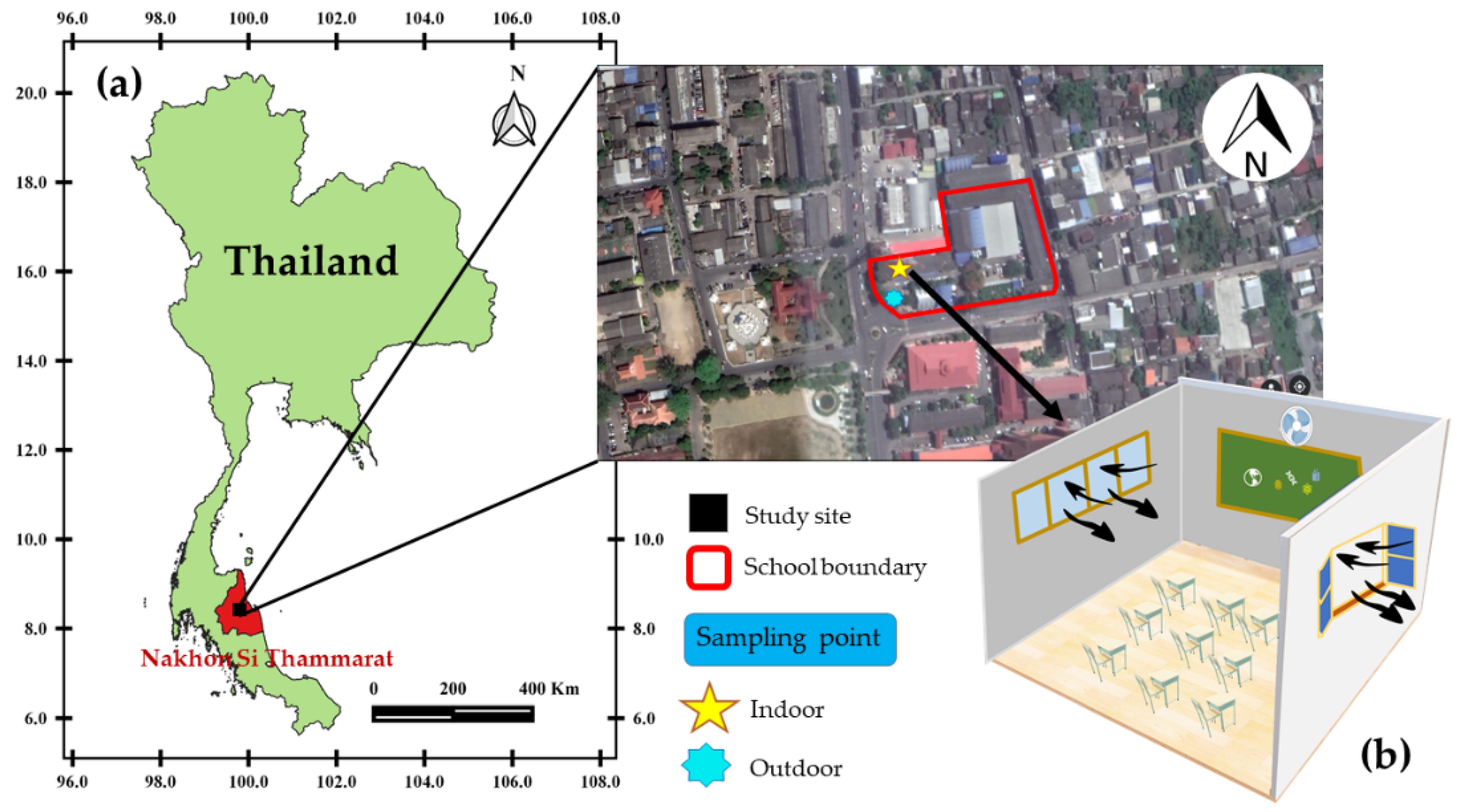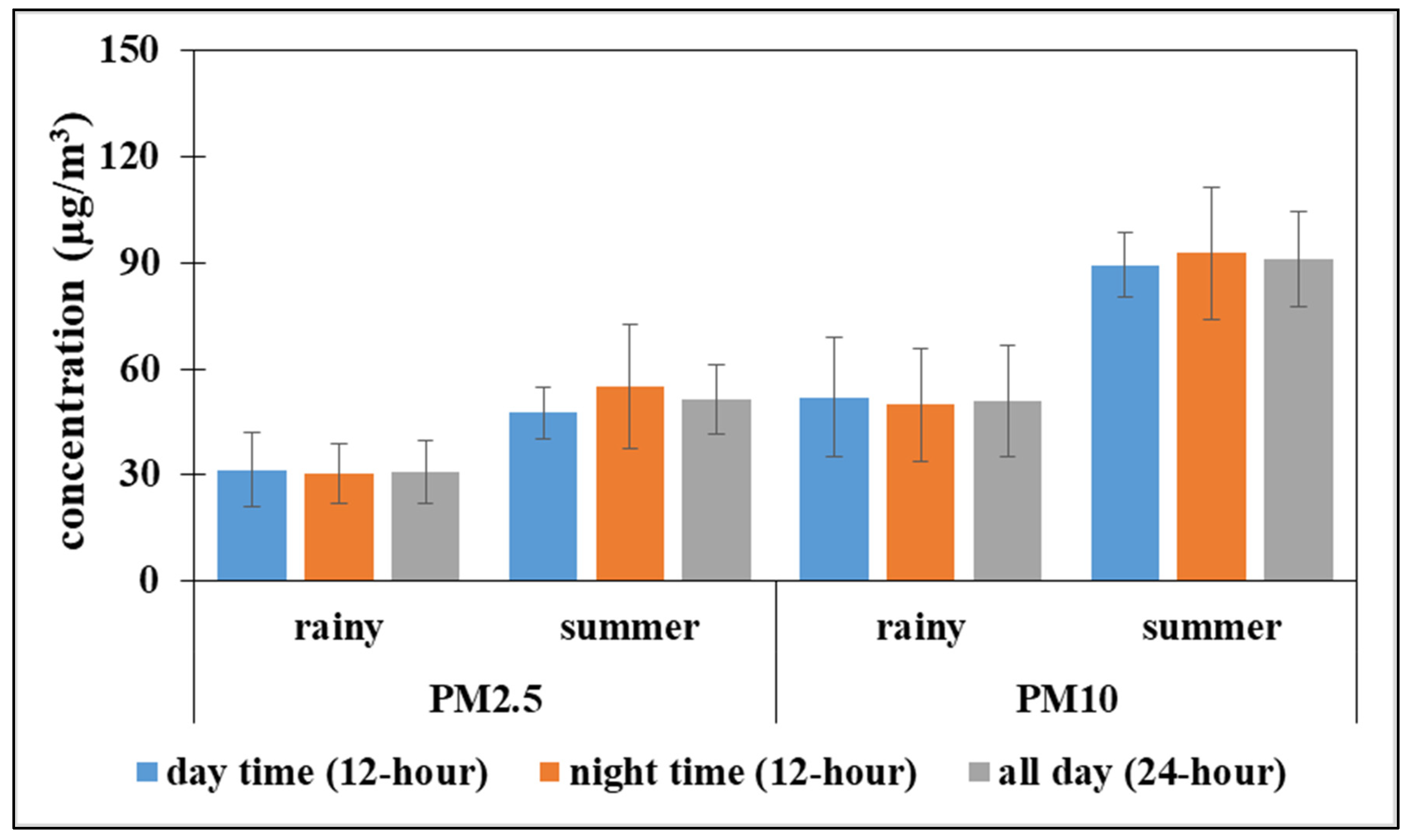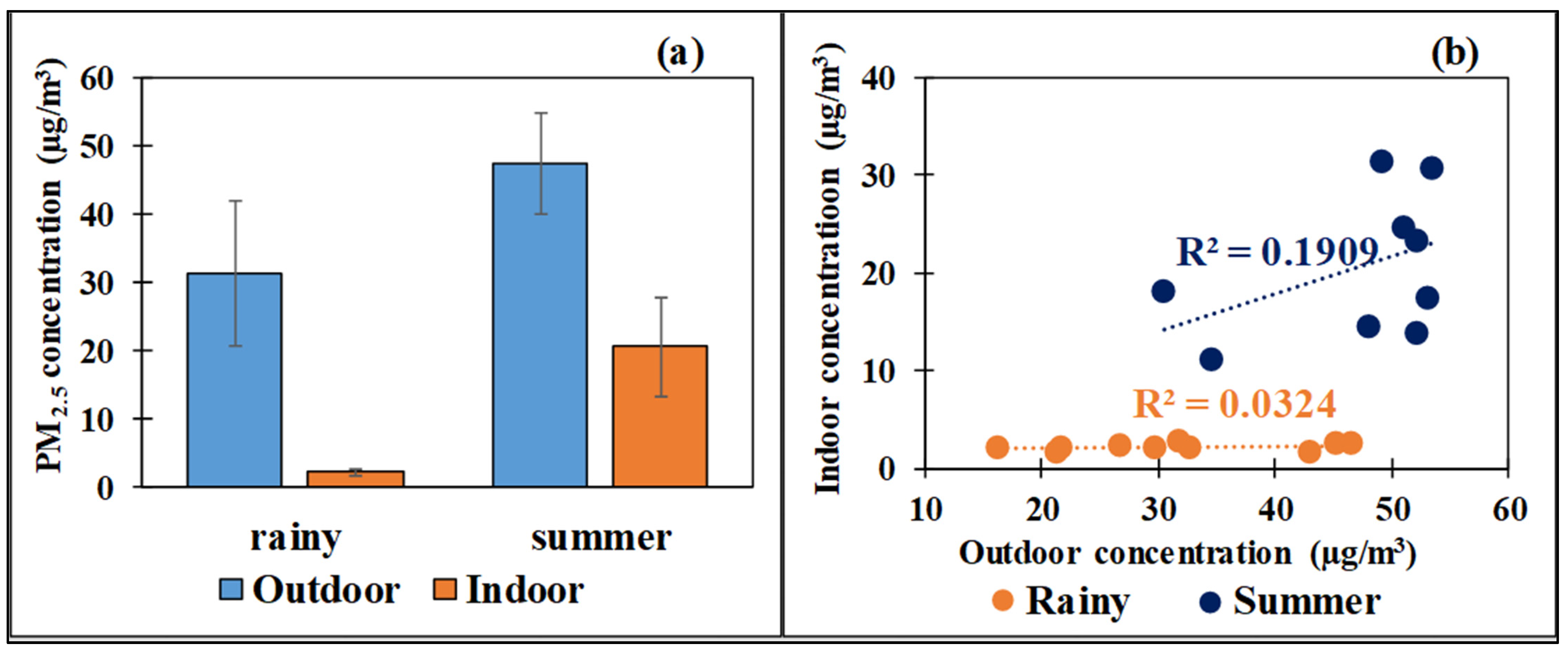Indoor Air Quality and Human Health Risk Assessment in the Open-Air Classroom
Abstract
:1. Introduction
2. Materials and Methods
2.1. Location of Study
2.2. Meteorological Conditions
2.3. Sampling of Air Pollutants
2.3.1. NO2 Sampling
2.3.2. PM Sampling
2.4. Statistical Analysis
2.5. Health Risk Assessment
| Exposed Parameters | Symbol | Unit | Young Children (1–5 Years) | Children (6–12 Years) | Teacher (>20 Years) |
|---|---|---|---|---|---|
| Concentration NO2 | mg/m3 | 0.063 | 0.063 | 0.063 | |
| Concentration PM2.5 | mg/m3 | 0.011 | 0.011 | 0.011 | |
| Inhalation rate | IR (1) | m3/hour | 0.32 | 0.46 | 0.54 |
| The exposure time | ET (2) | hours/day | 8 | 8 | 8 |
| The exposure frequency | EF (3) | days/year | 248 | 248 | 248 |
| The exposure duration | ED | years | 4 | 6 | 40 |
| Body weight | BW (1) | kg | 16 | 29 | 65 |
| The average time | AT | day | ED × 365 (day/year) | ||
3. Results and Discussions
3.1. NO2 Concentration
3.2. PM Concentration
3.3. Human Health Risk Assessment
4. Conclusions
Author Contributions
Funding
Institutional Review Board Statement
Informed Consent Statement
Data Availability Statement
Acknowledgments
Conflicts of Interest
References
- US EPA. Indoor Air Quality. An Official Website of the United States Government. 2021. Available online: https://www.epa.gov/report-environment/indoor-air-quality (accessed on 1 May 2021).
- Tran, V.V.; Park, D.; Lee, Y.-C. Indoor Air Pollution, Related Human Diseases, and Recent Trends in the Control and Improvement of Indoor Air Quality. Int. J. Environ. Res. Public Health 2020, 17, 2927. [Google Scholar] [CrossRef] [Green Version]
- Buka, I.; Koranteng, S.; Osornio-Vargas, A.R. The effects of air pollution on the health of children. Paediatr. Child. Health 2006, 11, 513–516. [Google Scholar] [CrossRef] [Green Version]
- Sunyer, J.; Esnaola, M.; Alvarez-Pedrerol, M.; Forns, J.; Rivas, L.; López-Vicente, M.; Suades-González, E.; Foraster, M.; Gar-cia-Esteban, R.; Basagaña, X.; et al. Association between Traffic-Related Air Pollution in Schools and Cognitive Development in Primary School Children: A Prospective Cohort Study. PLoS Med. 2015, 12, e1001792. [Google Scholar] [CrossRef]
- Leung, D.Y.C. Outdoor-indoor air pollution in urban environment: Challenges and opportunity. Front. Environ. Sci. 2015, 2, 69. [Google Scholar] [CrossRef]
- Shrestha, P.M.; Humphrey, J.L.; Carlton, E.J.; Adgate, J.L.; Barton, K.E.; Root, E.D.; Shelly, L.; Miller, S.L. Impact of Out-Door Air Pollution on Indoor Air Quality in Low-Income Homes during Wildfire Seasons. Int. J. Environ. Res. Public Health 2019, 16, 3535. [Google Scholar] [CrossRef] [Green Version]
- Becerra, J.A.; Lizana, J.; Gil, M.; Barrios-Padura, A.; Blondeau, P.; Chacartegui, R. Identification of potential indoor air pol-lutants in schools. J. Clean. Prod. 2020, 242, 118420. [Google Scholar] [CrossRef]
- Winkler, S.L.; Anderson, J.E.; Garza, L.; Ruona, W.C.; Vogt, R.; Wallington, T.J. Vehicle criteria pollutant (PM, NOx, CO, HCs) emissions: How low should we go? Npj Clim. Atmos. Sci. 2018, 1, 26. [Google Scholar] [CrossRef]
- Blondeau, P.; Iordache, V.; Poupard, O.; Genin, D.; Allard, F. Relationship between outdoor and indoor air quality in eight French schools. Indoor Air 2005, 15, 2–12. [Google Scholar] [CrossRef]
- Pallarés, S.; Gómez, E.; Martínez, A.; Jordán, M.M. The relationship between indoor and outdoor levels of PM10 and its chemical composition at schools in a coastal region in Spain. Heliyon 2019, 5, e02270. [Google Scholar] [CrossRef] [Green Version]
- World Health Organization (WHO). Natural Ventilation for Infection Control in Health-Care Settings; WHO Regional Office for Europe: Copenhagen, Denmark, 2009. [Google Scholar]
- Chen, J.; Brager, G.S.; Augenbroe, G.; Song, X. Impact of outdoor air quality on the natural ventilation usage of commercial buildings in the US. Appl. Energy 2019, 235, 673–684. [Google Scholar] [CrossRef]
- Laumbach, R.; Meng, Q.; Kipen, H. What can individuals do to reduce personal health risks from air pollution? J. Thorac. Dis. 2015, 7, 96–107. [Google Scholar] [CrossRef]
- Murena, F.; Mele, B. Effect of short-time variations of wind velocity on mass transfer rate between street canyons and the atmospheric boundary layer. Atmos. Pollut. Res. 2014, 5, 484–490. [Google Scholar] [CrossRef] [Green Version]
- Bootdee, S.; Chalemrom, P.; Chantara, S. Validation and field application of tailor-made nitrogen dioxide passive samplers. Int. J. Environ. Sci. Technol. 2012, 9, 515–526. [Google Scholar] [CrossRef] [Green Version]
- World Health Organization (WHO). Methods for Monitoring Indoor Air Quality in Schools. In Proceedings of the Methods for Monitoring Indoor Air Quality in Schools: Report of A Meeting, Bonn, Germany, 4–5 April 2011.
- Bhat, T.H.; Jiawen, G.; Farzaneh, H. Air Pollution Health Risk Assessment (AP-HRA), Principles and Applications. Int. J. Environ. Res. Public Health 2021, 18, 1935. [Google Scholar] [CrossRef]
- Lina, N.D.; Engelbrecht, J.C.; Wright, C.Y.; Oosthuizen, M.A.; Thabethe, N.D.L. Human health risks posed by exposure to PM10 for four life stages in a low socio-economic community in South Africa. Pan Afr. Med. J. 2014, 18, 206. [Google Scholar] [CrossRef]
- Lemly, A. Evaluation of the Hazard Quotient Method for Risk Assessment of Selenium. Ecotoxicol. Environ. Saf. 1996, 35, 156–162. [Google Scholar] [CrossRef]
- US EPA. Concepts Methods and Data Sources for Cumulative Health Risk Assessment of Multiple Chemicals, Exposures and Effects: A Resource Document, EPA/600/R-06/013F; US EPA: Washington, DC, USA, 2007.
- Garbero, V.; Montalto, A.; Lazovic, N.; Salizzoni, P.; Berrone, S.; Soulhac, L. The Impact of the Urban Air Pollution on the Human Health: A Case-Study in Turin. Air Pollut. Model. Its Appl. XXI 2011, 11, 729–732. [Google Scholar] [CrossRef]
- Oliveira, B.F.A.; Igotti, E.; Artzxo, P.; Saldiva, P.H.N.; Juger, W.L.; Hacon, S. Risk assessment of PM2.5 to child residents in Brazilian Amazon region with biofuel production. Environ. Health 2012, 11, 64. [Google Scholar] [CrossRef] [PubMed] [Green Version]
- Kumar, S.; Goyal, P. Health Risk of Ambient PM2.5 Concentration: A Case study of New Delhi, India. Int. J. Agric. Environ. Sustain. 2019, 1, 10–16. [Google Scholar]
- US EPA. The Risk Assessment Guidance for Superfund (RAGS) Part A. Office of Emergency and Remedial Response, U.S.A. 2010. Available online: https://www.epa.gov/risk/risk-assessment-guidance-superfund-rags-part (accessed on 1 May 2021).
- Prasertsin, S.; Nathapindhu, G. The Temporal Pattern of Ambient PM2.5 and Health Risk Assessment in Thailand. Indian J. Public Health Res. Dev. 2020, 11, 1096–1100. [Google Scholar]
- Gruszecka-Kosowska, A. Assessment of the Kraków inhabitants’ health risk caused by the exposure to inhalation of outdoor air contaminants. Stoch. Environ. Res. Risk Assess. 2018, 32, 485–499. [Google Scholar] [CrossRef] [Green Version]
- Abdul-Wahab, S.A.; En, S.C.F.; Elkamel, A.; Ahmadi, L.; Yetilmezsoy, K. A review of standards and guidelines set by international bodies for the parameters of indoor air quality. Atmos. Pollut. Res. 2015, 6, 751–767. [Google Scholar] [CrossRef]
- New Zealand Government. Ambient Air Quality Guidelines: 2002 Update; New Zealand Government: Wellington, New Zealand, 2002. Available online: https://environment.govt.nz/facts-and-science/air/air-pollutants/nitrogen-dioxide-effects-health/ (accessed on 10 May 2021).
- Ministry of the Environment Government of Japan. Environmental Standards for Nitrogen Dioxide; Ministry of the Environment Government of Japan: Tokyo, Japan, 2020. Available online: https://www.env.go.jp/kijun/taiki2.html (accessed on 13 May 2021).
- South Korea’s Ambient Air Quality Standards. 2018. Available online: https://www.transportpolicy.net/standard/south-korea-air-quality-standards/ (accessed on 10 May 2021).
- Janta, R.; Kaewrat, J.; Rattikansukha, C.; Sichum, S. Measurement of Nitrogen Dioxide Concentration in Traffic Areas of Nakhon Si Thammarat Province and Health Risk Assessment. J. KMUTNB 2020, 30, 481–494. (In Thai) [Google Scholar] [CrossRef]
- Cros, C.J.; Terpeluk, A.L.; Crain, N.E.; Juenger, M.C.; Corsi, R.L. Influence of environmental factors on removal of oxides of nitrogen by a photocatalytic coating. J. Air Waste Manag. Assoc. 2015, 65, 937–947. [Google Scholar] [CrossRef] [Green Version]
- Hwang, S.H.; Park, W.M. Indoor air concentrations of carbon dioxide (CO2), nitrogen dioxide (NO2), and ozone (O3) in multiple healthcare facilities. Environ. Geochem. Health 2020, 42, 1487–1496. [Google Scholar] [CrossRef]
- Chatzidiakou, L.; Mumovic, D.; Summerfield, A.J. What do we know about indoor air quality in school classrooms? A critical review of the literature. Intell. Build. Int. 2012, 4, 228–259. [Google Scholar] [CrossRef]
- Kalimeri, K.K.; Bartzis, J.G.; Sakellaris, I.A.; de Oliveira Fernandes, E. Investigation of the PM2.5, NO2 and O3 I/O ratios for office and school microenvironments. Environ. Res. 2019, 179, 108791. [Google Scholar] [CrossRef]
- Salonen, H.; Salthammer, T.; Morawska, L. Human exposure to NO2 in school and office indoor environments. Environ. Int. 2019, 130, 104887. [Google Scholar] [CrossRef] [PubMed]
- Xu, G.; Jiao, L.; Zhang, B.; Zhao, S.; Yuan, M.; Gu, Y.; Liu, J.; Tang, X. Spatial and Temporal Variability of the PM2.5/PM10 Ratio in Wuhan, Central China. Aerosol Air Qual. Res. 2016, 17, 741–751. [Google Scholar] [CrossRef] [Green Version]
- Adães, J.; Pires, J.C.M. Analysis and Modelling of PM2.5 Temporal and Spatial Behaviors in European Cities. Sustainability 2019, 11, 6019. [Google Scholar] [CrossRef] [Green Version]
- Kanchanasuta, S.; Sooktawee, S.; Patpai, A.; Vatanasomboon, P. Temporal Variations and Potential Source Areas of Fine Particulate Matter in Bangkok, Thailand. Air Soil Water Res. 2020, 13, 1–10. [Google Scholar] [CrossRef]
- Meier, R.; Eeftens, M.; Phuleria, H.C.; Ineichen, A.; Corradi, E.; Davey, M.; Fierz, M.; Ducret-Stich, R.E.; Aguilera, I.; Schindler, C.; et al. Differences in indoor versus outdoor concentrations of ultrafine particles, PM2.5, PMabsorbance and NO2 in Swiss homes. J. Expo. Sci. Environ. Epidemiol. 2015, 25, 499–505. [Google Scholar] [CrossRef]
- Cichowicz, R.; Dobrzański, M. Indoor and Outdoor Concentrations of Particulate Matter and Gaseous Pollutants on Different Floors of a University Building: A Case Study. J. Ecol. Eng. 2021, 22, 162–173. [Google Scholar] [CrossRef]
- Barmpadimos, I.; Hueglin, C.; Keller, J.; Henne, S.; Prevot, A. Influence of meteorology on PM10 trends and variability in Switzerland from 1991 to 2008. Atmos. Chem. Phys. Discuss. 2011, 11, 1813–1835. [Google Scholar] [CrossRef] [Green Version]
- Hernandez, G.; Berry, T.-A.; Wallis, S.L.; Polyer, D. Temperature and Humidity Effects on Particulate Matter Concentrations in a Sub-Tropical Climate during Winter. Int. Proc. Chem. Biol. Environ. Eng. 2017, 102, 41–49. [Google Scholar]
- Kapwata, T.; Language, B.; Piketh, S.; Wright, C.Y. Variation of Indoor Particulate Matter Concentrations and Association with Indoor/Outdoor Temperature: A Case Study in Rural Limpopo, South Africa. Atmosphere 2018, 9, 124. [Google Scholar] [CrossRef] [Green Version]
- Di Gilio, A.; Farella, G.; Marzocca, A.; Giua, R.; Assennato, G.; Tutino, M.; de Gennaro, G. Indoor/Outdoor Air Quality As-sessment at School near the Steel Plant in Taranto (Italy). Adv. Meteorol. 2017, 2017, 1526209. [Google Scholar] [CrossRef] [Green Version]
- Kaewrat, J.; Janta, R. Health Risk Assessment of Residents in a Tourist City: A Case Study of Nakhon Si Thammarat Province. Walailak J. Sci. Techol. 2021, 18, 11510. [Google Scholar]
- Bootdee, S.; Phantu, S.; Lamlongrat, P.; Khumphai, T. Indoor Nitrogen Dioxide Investigation and Health Risk Assessment in Primary Schools at Rayong City, Thailand. Curr. J. Appl. Sci. 2020, 19, 248–262. [Google Scholar]
- Cheng, Z.; Li, B.; Yu, W.; Wang, H.; Zhang, T.; Xiong, J.; Bu, Z. Risk assessment of inhalation exposure to VOCs in dwellings in Chongqing, China. Toxicol. Res. 2017, 7, 59–72. [Google Scholar] [CrossRef] [Green Version]
- Du, Z.; Mo, J.; Zhang, Y. Risk assessment of population inhalation exposure to volatile organic compounds and carbonyls in urban China. Environ. Int. 2014, 73, 33–45. [Google Scholar] [CrossRef]
- Annesi-Maesano, I.; Baiz, N.; Banerjee, S.; Rudnai, P.; Rive, S. Indoor Air Quality and Sources in Schools and Related Health Effects. J. Toxicol. Environ. Health Part B 2013, 16, 491–550. [Google Scholar] [CrossRef]
- Carrion-Mattaa, A.; Kanga, C.-M.; Gaffin, J.M.; Hauptman, M.; Phipatanakul, W.; Koutrakisa, P.; Gold, D.R. Classroom in-door PM2.5 sources and exposures in inner-city schools. Environ. Int. 2019, 131, 104968. [Google Scholar] [CrossRef] [PubMed]
- Occupational Safety and Health Administration (OSHA). Indoor Air Quality in Commercial and Institutional Buildings; Occupational Safety and Health Administration U.S. Department of Labor: Washington, DC, USA, 2011. Available online: https://www.osha.gov/sites/default/files/publications/3430indoor-air-quality-sm.pdf (accessed on 1 May 2021).
- Faus-Kessler, T.; Kirchner, M.; Jakobi, G. Modelling the decay of concentrations of nitrogenous compounds with distance from roads. Atmos. Environ. 2008, 42, 4589–4600. [Google Scholar] [CrossRef]
- Liu, S.V.; Chen, F.-L.; Xue, J. A meta-analysis of selected near-road air pollutants based on concentration decay rates. Heliyon 2019, 5, e02236. [Google Scholar] [CrossRef] [PubMed] [Green Version]
- Hitchins, J.; Morawska, L.; Wolff, R.; Gilbert, D. Concentrations of submicrometre particles from vehicle emissions near a major road. Atmos. Environ. 2000, 34, 51–59. [Google Scholar] [CrossRef] [Green Version]
- Tong, Z.; Baldauf, R.W.; Isakov, V.; Deshmukh, P.; Zhang, K.M. Roadside vegetation barrier designs to mitigate near-road air pollution impacts. Sci. Total. Environ. 2016, 541, 920–927. [Google Scholar] [CrossRef]
- Abhijith, K.; Kumar, P.; Gallagher, J.; McNabola, A.; Baldauf, R.; Pilla, F.; Broderick, B.; DI Sabatino, S.; Pulvirenti, B. Air pollution abatement performances of green infrastructure in open road and built-up street canyon environments—A review. Atmos. Environ. 2017, 162, 71–86. [Google Scholar] [CrossRef]





| Parameters | Sampling Period | Outdoor | Indoor | ||
|---|---|---|---|---|---|
| Time | Sample Number | Time | Sample Number | ||
| NO2 | November 2019–February 2020 | 24 h | 48 | 24 h | 48 |
| PM2.5 | February–March 2020, January 2021 | 7:00 a.m.–7:00 p.m.; 7:00 p.m.–7:00 a.m. | 20 20 | 8:00 a.m.–4:00 p.m. - | 20 - |
| PM10 | February–March 2020, January 2021 | 7:00 a.m.–7:00 p.m.; 7:00 p.m.–7:00 a.m. | 20 20 | - - | - - |
Publisher’s Note: MDPI stays neutral with regard to jurisdictional claims in published maps and institutional affiliations. |
© 2021 by the authors. Licensee MDPI, Basel, Switzerland. This article is an open access article distributed under the terms and conditions of the Creative Commons Attribution (CC BY) license (https://creativecommons.org/licenses/by/4.0/).
Share and Cite
Kaewrat, J.; Janta, R.; Sichum, S.; Kanabkaew, T. Indoor Air Quality and Human Health Risk Assessment in the Open-Air Classroom. Sustainability 2021, 13, 8302. https://doi.org/10.3390/su13158302
Kaewrat J, Janta R, Sichum S, Kanabkaew T. Indoor Air Quality and Human Health Risk Assessment in the Open-Air Classroom. Sustainability. 2021; 13(15):8302. https://doi.org/10.3390/su13158302
Chicago/Turabian StyleKaewrat, Jenjira, Rungruang Janta, Surasak Sichum, and Thongchai Kanabkaew. 2021. "Indoor Air Quality and Human Health Risk Assessment in the Open-Air Classroom" Sustainability 13, no. 15: 8302. https://doi.org/10.3390/su13158302
APA StyleKaewrat, J., Janta, R., Sichum, S., & Kanabkaew, T. (2021). Indoor Air Quality and Human Health Risk Assessment in the Open-Air Classroom. Sustainability, 13(15), 8302. https://doi.org/10.3390/su13158302






